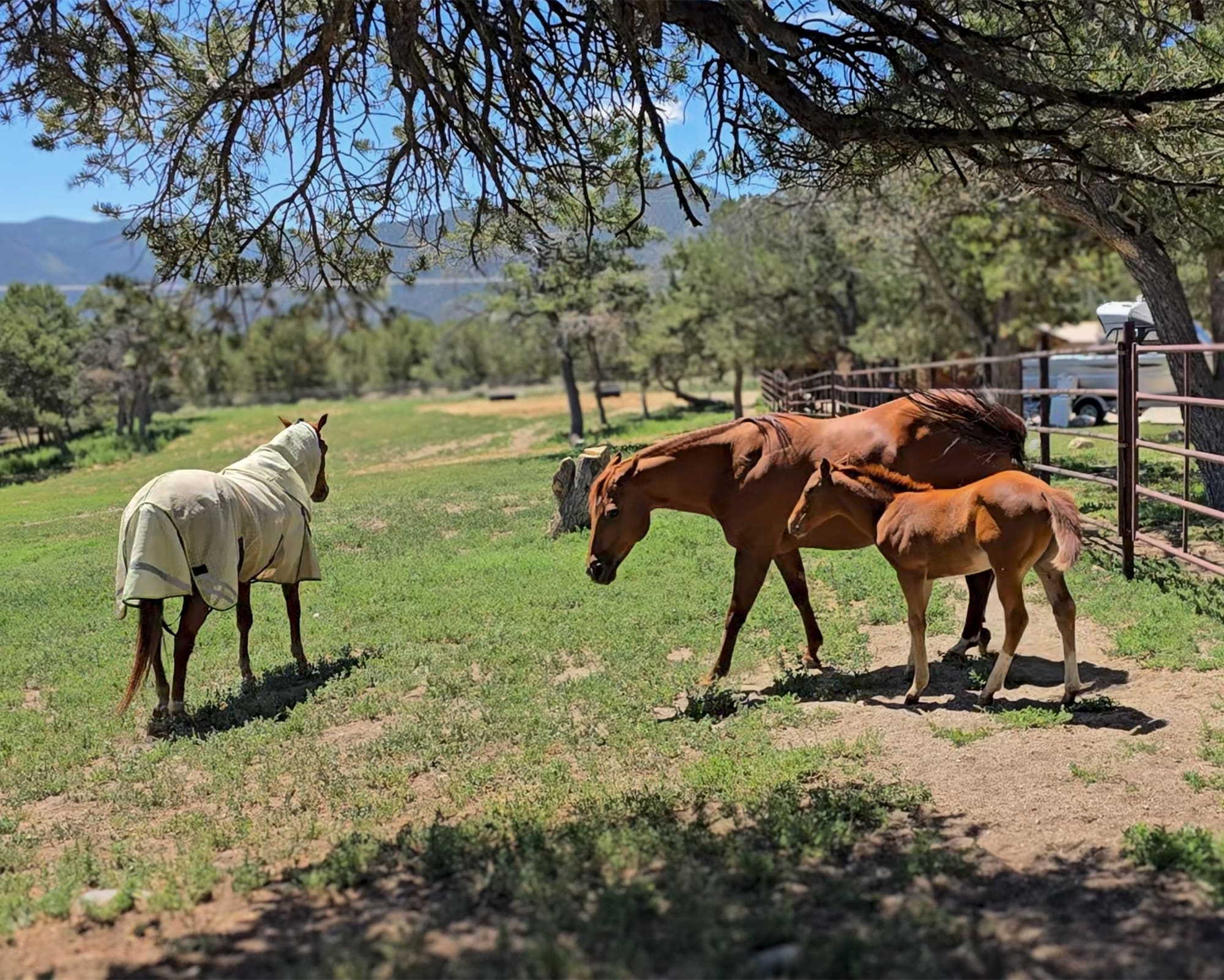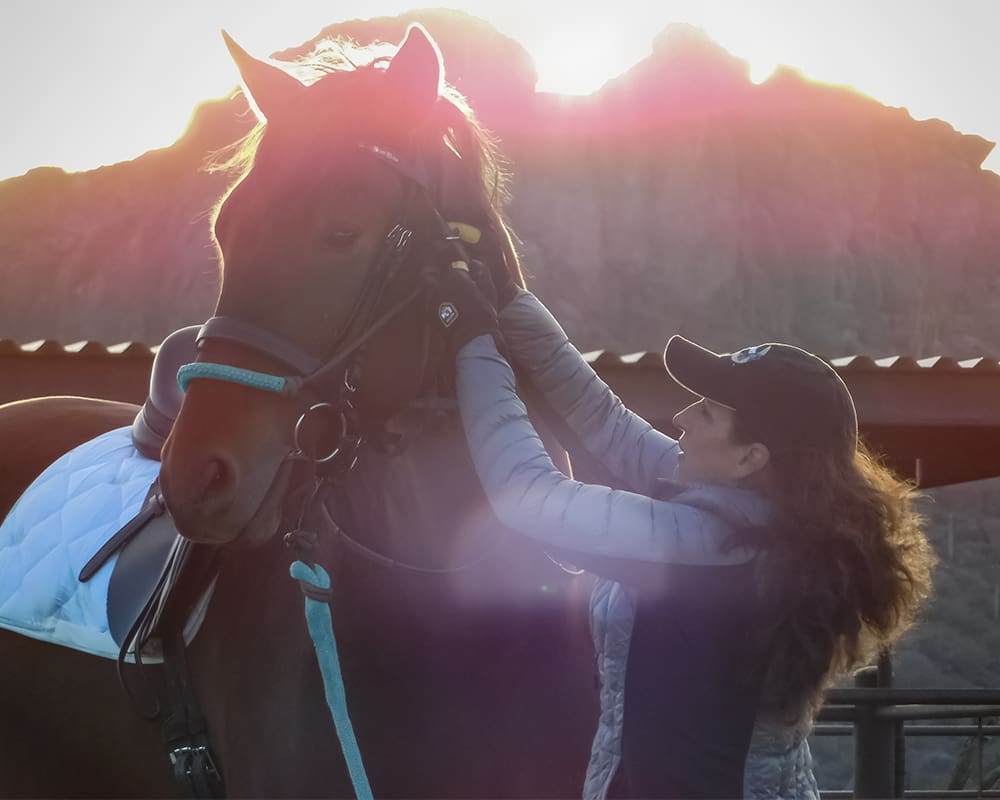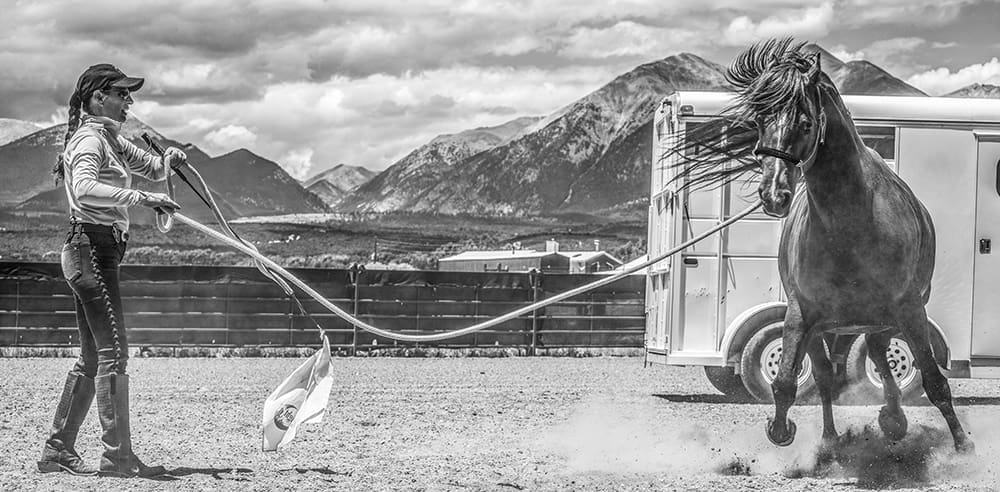
The first time I saw and understood this behavioral dynamic, between a horse and its rider, was about twenty years ago at a clinic for people learning to manage their fear of horses. I’ve seen it many times since, enough to recognize the cause and effect. When a rider fears their horse will kick at another horse while being ridden, it quickly becomes a self-fulfilling prophecy.
Typically, at fear management clinics, I would conduct a meet-and-greet the night before the clinic where we all came together to talk and process, sharing stories of what brought the riders there. Many people had horrific stories of an incident with a horse and losing their confidence. One woman shared that she lost her confidence when she was at a horse show and her horse was kicked by another horse. What are the odds that very horse would show up at my clinic the next day?
I arrived t the clinic site early the next morning and was greeted by this woman who had seen the horse that kicked at her; she was almost hysterical. “That’s the very horse that kicked at me and caused me to lose my confidence,” she cried. She was in the midst of packing up and leaving. I could see this was going to be a challenging day.
I talked her down off the ledge and kept the horses separated as much as possible. I had the riders mount up only two at a time, so that they weren’t overwhelmed with so many horses in the arena. When it came time for the alleged kicking horse to come in the arena, the mare was decked out with a dozen red ribbons in her tail and her rider was clearly nervous and almost panicking any time the other horse came anywhere near her horse. I was beginning to see the problem.
Recently I was at another clinic and saw this very same dynamic—the rider cueing the horse to kick. Horses often act the way we expect them to. When the rider gets so wrapped up in worrying about what bad thing she thinks her horse is going to do, the horse usually complies. Your job as the leader is to be aware of the environment, to keep your horse out of danger and to tell your horse what to do and how to act. When a rider starts focusing on what could go wrong, becomes defensive or frightened and then freezes up on the horse, she has abdicated her authority as the leader and the horse takes over in that moment.
What Message are You Sending Your Horse?
Horses are herd animals and as a result, they take emotional and behavioral cues from the horses around them. When one horse gets frightened, they all do. Additionally, horses communicate with each other primarily with body language and postures and they are masters at reading the body language of other horses and people. We know that horses, whether trained or not, respond differently to different people—they see each person as an individual.
When a person handles a horse with calmness, strength and confidence, the horse generally responds with relaxation, acceptance and subordinance. Conversely, when the handler is nervous, agitated and defensive, the horse responds in kind. I’ll admit that maintaining a cool demeanor on the outside when you’re not feeling that way in the inside, is not always easy, but it’s an important skill to master.
Now, picture the scene described above with riders that are fearful and a horse that has a history of kicking at other horses while being ridden. Instead of focusing ahead of her and proactively riding the horse forward, the rider was nervously looking behind her, clenching the reins, shouting-out her fear of an approaching horse. While the rider thought she was looking out for and avoiding danger, the horse thought the approaching horse was the enemy, felt the defensiveness of the rider and consequently lashed out at the approaching horse. In that moment, the rider telegraphed her fear and defensiveness to her horse and the horse responded in the way horses do when they become defensive—kicking out.
Being aware of your body language and emotional behavior, and the message you are sending your horse is not easy for everyone but it is an important skill for working with horses. Controlling your emotional behavior—taking a deep breath, relaxing, conveying strength and confidence even when you don’t feel that way—makes a huge impact on horses. There’s a saying we like to use about this… “No matter how your feel on the inside, never show your weakness on the outside.”
Think Forward
Many riders, at the first sign things are not going the way they want, will stop their horse, in an effort to re-establish control. This is not usually the right thing to do. One of the strongest tenants of horse training—a concept that has survived thousands of years—is that forward motion is the basis of all training. Without forward motion, a horse cannot be trained. Horse training involves the ability to establish and control the forward movement of the horse.
When a nervous rider feels like something is going wrong, the first thing she typically does is pull back on the reins in an effort to stop the horse and gain control. But you are only in control, when you are controlling forward movement. Riding away from a “bad spot,” toward another safer destination is usually a better answer.
Additionally, although horses are flight animals and prefer to run away from danger, they also prefer to conserve their energy in case it is needed for flight. As a result, horses can be a little lazy at times and they often perceive stopping and resting as a reward. If every time a horse displays undesirable behavior, we let him stop and rest, we are rewarding and reinforcing the undesirable behavior.
Using the example of the mare with red ribbons in her tail, first the rider conveyed her fear of the approaching horse and her defensiveness, causing the horse to focus on the approaching enemy and become defensive herself. Then, in a panic, the rider pulls back on the reins, stopping the horse and clenching the reins in panic, sending a message of fear to the horse and abdicating her responsibility as the leader. Unfortunately, this puts the horse right in harm’s way as the other horse gets closer, leading to an obvious result of the mare kicking out in defense. This is the unfortunate dynamic that teaches the horse to kick other horses while being ridden.
If instead, the rider is focused forward, aware of the environment and riding the horse away from “danger” well ahead of any problem, the horse stays focused on what’s ahead, not what is behind. If every time the horse acts untoward, the rider asks for more forward movement and rides toward a
destination (ride forward and go somewhere), the horse learns that the untoward behavior gets him nothing but more work, so it doesn’t really pay off.
I realize this is a tall order for many riders—to stay calm and focused on the positive outcome, to show confidence and leadership even when you don’t feel that way, and to ride the horse more forward even when your greatest wish is to stop and get off. These are not riding skills; they are mental skills. This is not about how good a rider you are, but about how effective a leader you are.
Everyone, even the most confident leader you know, experiences self-doubt at times. It’s what you do I that moment that matters. With horses, being aware of and in control of your body language and emotions is critical. Thinking forward and focusing ahead, not behind you, will bring your horse’s attention to what is coming next.
That mare with the red ribbons on her tail? As soon as the rider understood the dynamics that existed and that she was causing the mare’s defensive behavior, she began to ride the horse forward out of trouble and the disturbing kicking behavior went away immediately. Once the rider was able to make the horse understand she expected something different from her horse, the red ribbons were no longer needed.



